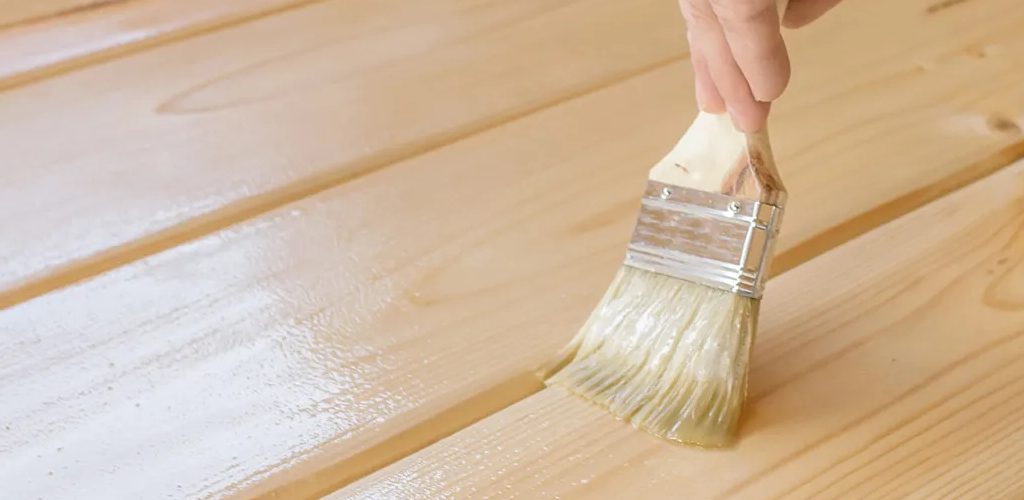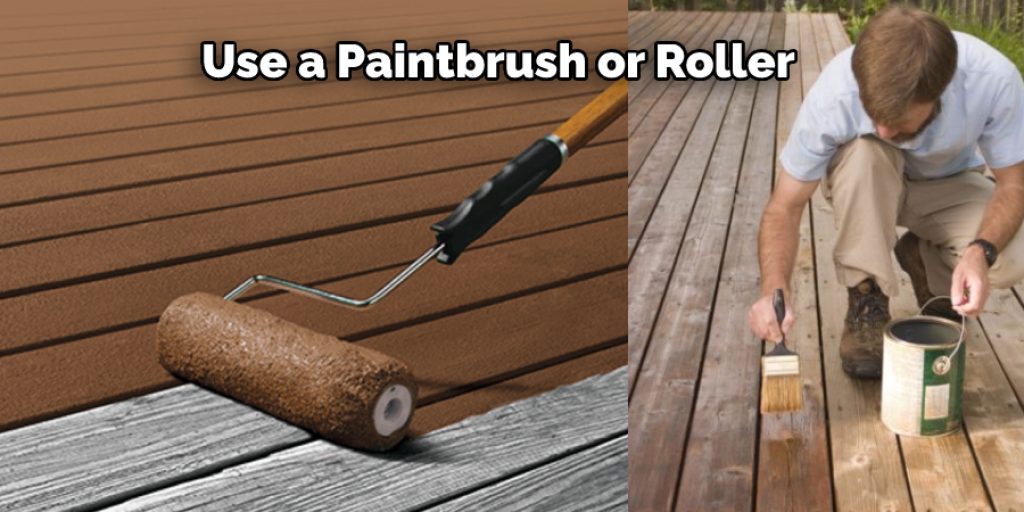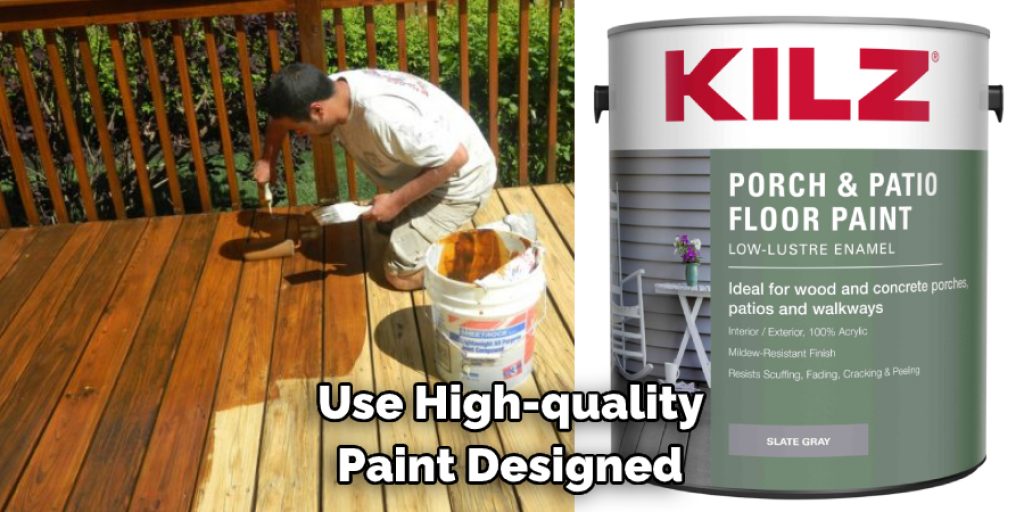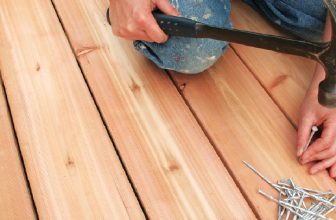How to Paint a Deck With Peeling Paint
Painted decks are a popular outdoor feature, but the paint can peel and flake over time. If this happens, it’s important to repaint the deck as soon as possible to protect it from the elements. While this may seem daunting, the process is quite simple.

This blog post will show you how to paint a deck with peeling paint using our easy steps. With just a few supplies and some elbow grease, you can have your deck looking like new in no time. So, if your deck needs some updating, be sure to follow these steps! Then, keep reading for more information!
10 Common Reasons That Causes Peeling Paint in Deck
1. Paint Was Applied Too Thickly:
When painting a deck, it’s important to apply the paint evenly and thinly. A thick coat of paint will peel within a few years.
2. The Paint Was Applied in the Wrong Weather:
If you paint your deck when it’s too hot or too cold, the paint will start to peel. Therefore, paint needs to be applied in moderate weather conditions so that it dries correctly and doesn’t peel.
3. Poor Quality Paint:
If you’re dealing with a deck that has peeling paint, the problem might be due to the quality of the paint itself. In some cases, low-quality paints can start to peel and chip soon after they’re applied. So if your deck has been painted with low-quality paint, you might need to repaint it with a higher-quality product.
4. Moisture:
Another common cause of peeling paint is moisture. If your deck is constantly exposed to water, it can cause the paint to start peeling and flaking off. To prevent this from happening, you’ll need to ensure that your deck is properly sealed and waterproofed. You might also need to apply a primer before painting to help create a barrier between the paint and the deck.
5. Too Much Heat:
Like extreme cold can cause paint to peel, too much heat can also cause problems. If your deck is constantly exposed to hot sun, the paint can start to blister and peel.

6. Poor Preparation:
If you don’t prepare your deck properly before painting it, the paint will start to peel soon afterward. In most cases, you’ll need to sand down the deck and apply a primer before painting.
7. Improper Cleaning:
If you don’t clean your deck thoroughly before painting it, the paint will have trouble adhering to the surface. This can cause the paint to start peeling within a few months. So be sure to clean your deck with a pressure washer and a detergent before painting.
8. Incorrect Painting Technique:
If you’re not careful, you might end up with a deck that looks like it’s been painted by a toddler. If the paint is peeling off your deck, it’s probably because you didn’t apply it correctly in the first place. Make sure to stir the paint well before using it, and be sure to brush it on evenly. Don’t forget to paint the sides and top of the deck too!
9. Not Enough Protection:
If you don’t protect your deck properly, the paint will start to peel off after just a few months. Make sure to cover the deck with a coat of sealant or vanish after you’ve painted it, and be sure to reapply the sealant every few years.
10. Lack of Maintenance:
If you don’t maintain your deck properly, the paint will start to peel and chip within a few years. Be sure to inspect your deck regularly for peeling paint, and be sure to sand down and repaint any areas that are starting to show wear. With a little bit of effort, you can keep your deck looking great for years to come!

10 Easy Ways on How to Paint a Deck With Peeling Paint
1. Clean the Surface of the Deck:
Before you start painting, it is important to clean the surface of your deck. This will remove any dirt or debris on the surface and help the paint adhere better.
2. Apply a Primer:
If your deck has any peeling paint, you will want to apply a primer before painting. This will help cover up the peeling paint and help the new paint adhere better.
3. Use a Paintbrush or Roller:
Once you have applied the primer, you can start painting the deck with a paintbrush or roller. If you are using a paintbrush, use long strokes to avoid leaving brush strokes in the paint.
4. Broom or Vacuum to Remove Any Dust:
Once you have finished painting, you will want to broom or vacuum the deck’s surface to remove any dust or debris. This will help to keep your deck looking nice and clean.
5. Paint in the Shade:
If possible, try to paint your deck in the shade. This will help to prevent the paint from drying too quickly, which can cause streaks and brush marks. Also, be sure to protect any plants or flowers in the area from paint fumes.
6. Remove All Debris:
Before you start painting, be sure to remove any debris or dirt from the surface of your deck. This will ensure that the paint adheres properly and creates a smooth, even finish.
7. Wash the Surface:
Once you’ve removed all the debris, it’s time to wash the surface of your deck. You can do this with a garden hose or a pressure washer. Be sure to use a gentle spray and avoid getting the paint wet.
8. Use a Paint Sprayer:
If you have a paint sprayer, you can use it to paint your deck. This is a quick and easy way to get an even coat of paint on your deck. Just be sure to follow the manufacturer’s instructions carefully.

9. Use a Scraper or Wire Brush:
Once the deck has been cleaned, it’s time to remove any peeling paint. A scraper or wire brush can be used to remove the loose paint. Wear gloves and safety goggles while doing this, as the paint chips can be sharp and may cause injury.
10. Let the Paint Dry:
Once the paint has been applied, it is essential to let it dry before using the deck. This can take anywhere from a few hours to a few days depending on the paint. Once the paint has dried, you can enjoy your newly painted deck!
Some Tips to Prevent Peeling Paint on Deck Surfaces
- Clean the deck surface thoroughly before painting. Make sure to remove all dirt, dust, and debris.
- Prime the deck surface with a primer designed for decks. This will help create a barrier between the wood and the paint, making it less likely to peel.
- Use high-quality paint designed for decks. Cheap paints can peel more paint designed for decks. This type of paint is usually more durable and less likely to peel.
- Apply several coats of paint, allowing each coat to dry completely before adding the next. This will help create a stronger bond between the paint and the wood, making it less likely to peel.
- 5. Avoid painting in direct sunlight or in extreme weather conditions. Painting in these conditions can cause the paint to dry too quickly, leading to peeling.
- Regularly maintain the deck surface by cleaning and sealing it with a sealant designed for decks. This will help prolong the life of the paint and prevent peeling.
- Repair any damage to the deck surface before painting. For example, damaged wood is more likely to peel paint.
You can help prevent peeling paint on your deck surface by following these tips.
Can You Paint Over Paint That Is Peeling?
Yes, you can paint over peeling paint, but it is not recommended. The new paint will not adhere well to the old paint, and the peeling paint will likely chip and flake off. Therefore, it is best to remove the old paint before painting again in most cases.
If the paint is peeling due to poor adhesion (not allowing the paint to properly “bite” into the surface), you may be able to improve the situation by sanding the surface before painting. This will rough up the surface and allow the new paint to adhere better.

Do You Have to Remove Old Deck Paint Before Repainting?
If your deck paint is peeling, you may be wondering if you have to remove the old paint before repainting. In most cases, you don’t have to remove the old paint. However, if the old paint is severely peeling or chipping, it’s best to remove it before repainting.
You can use a stripper or a pressure washer to remove the old paint. If you’re using a stripper, follow the directions carefully. A pressure washer can also be used, but be careful not to damage the wood.
Final Thoughts
Painting a deck is not as difficult as it may seem, but there are some essential things to remember to achieve the best results. By following the steps we outlined in this post and using high-quality paint, you can give your deck a fresh new look that will last for years.
We hope this guide on how to paint a deck with peeling paint has been helpful. Have you ever painted a deck before? What tips would you add? Let us know in the comments below!
You can check it out to Fill Gaps in Wood Deck




